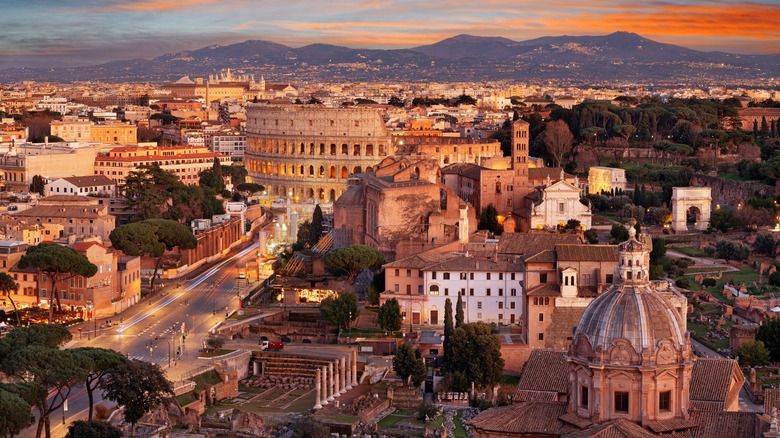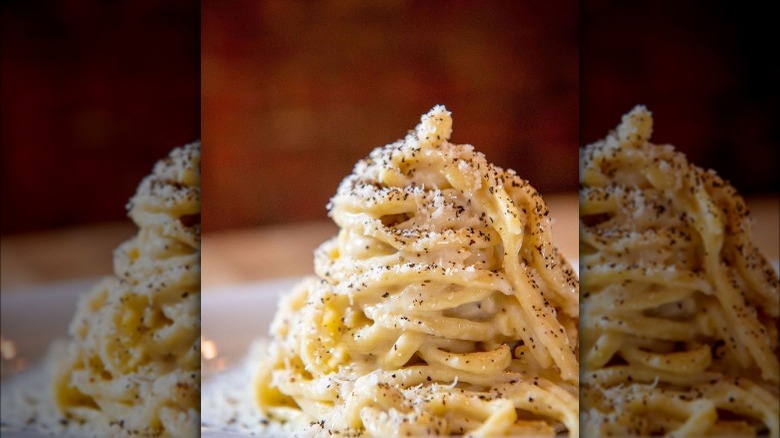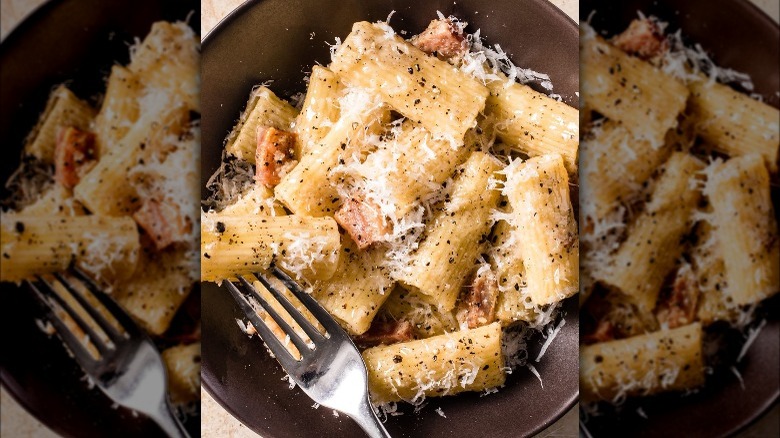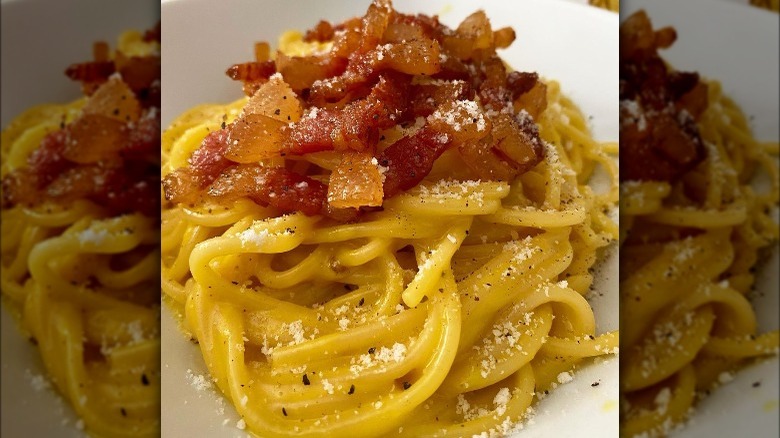These Are The 4 Traditional Pastas Of Rome
As the mercury continues to drop, it's time to embrace all things cozy. Nothing says "here, let me warm you up" better than comfort foods. And few dishes make you feel more contented than pasta. If, however, you are growing weary of spaghetti and meatballs, here is a novel idea: Why not explore the four classic pasta dishes of Rome? Not only will you get to enjoy a new culinary experience and steep yourself in this ancient city's history, but you may actually capture the essence of Rome and its warmer climes.
Italy has always been a nation known for its food and Italians take great pride in this. In fact, Cook's Illustrated points out that "Oxford Companion to Italian Food" writer Gillian Riley once said, "myths about food and recipes are part of Italian culture, a way of fondly expressing pride in a rich gastronomic heritage." In Rome, these stories focus on the city's four traditional dishes. Food52 says that, according to myth, a group of shepherds from Abruzzi created these four dishes using items found in their backpacks: pancetta, pecorino, olive oil, black pepper, and an egg or jar of tomato sauce. Others say that this pasta quartet did originate in Abruzzi, but the founders weren't shepherds. They were immigrants who opened Roman eateries like "osterie and trattorie" instead.
So what are the famed pasta dishes that make up this collection? Maybe you've heard of them.
Cacio e pepe
First up is cacio e pepe. Alton Brown points out that its name translates to "cheese and pepper," providing you with a glimpse of this dish's nature. Brown adds that this creation also "exploits the marvels" of pasta water and its "starchy goodness." What exactly is cacio e pepe and why do the Romans hold it in such high esteem?
According to Epicurious, cheese and pepper have the leading roles in cacio e pepe. Supporting roles go to butter, olive oil, and pasta water. Traditionally, the cheese is Pecorino Romano, though some modern versions call for Grana Padano or Parmesan. Historically, this dish calls for the thick and lengthy pasta called tonnarelli, but you can also opt for bucatini or linguine in a pinch. Serious Eats does offer some advice for making cacio e pepe such as recommending that you finely grate your cheese in order to help out with the melting process. They also suggest using two separate pans, one for cooking the pasta and the other for creating your sauce. You can, then, easily put your finished pasta right into the second pan.
If you'd like to try your hand at this authentic Roman dish, you may want to try Lupa's Cacio E Pepe from the famed New York City restaurant.
Pasta alla Gricia
Up next is pasta alla Gricia, a dish that Recipes From Italy calls "one of the oldest and simplest pasta recipes in Roman cuisine." While many tend to think of Italian dishes as being smothered in thick, tomato-centric sauces, pasta alla Gricia predates the tomato's introduction to Europe.
Serious Eats says that this "beautiful dish" uses a sauce that is made from "rendered guanciale, black pepper, pasta water, and grated Pecorino Romano cheese." And for those who say you can replace the guanciale with pancetta, the outlet says no, no, no. The two have completely different tastes and this dish calls for guanciale's "all up in your face" flavor, not pancetta's more subdued one. While Recipes From Italy contends that traditionally it calls for rigatoni or mezze maniche (which are similar but shorter), MasterClass adds that tonnarelli or spaghetti will also work. They also recommend using a "few cups" less water than usual in order to create water with a higher concentration of starch. This will add to the dish's overall creaminess.
Are you eager to give this classic Roman dish a shot? Chef Billy Parisi's authentic pasta alla Gricia recipe may be a great one to master.
Amatriciana
Meet Amatriciana, the third dish in the collection. Serious Eats declares that Romans likely have immigrants from the Apennine mountains to thank for this offering, which Rome-based author and tour guide Katie Parla calls gricia's baby sibling. It is, after all, practically the same recipe except for the addition of tomatoes. According to the Accademia Italiana Chef, the first written account of Amatriciana was in 1816 when cook Francesco Leonardi served it at the papal court. Historically speaking, it isn't all that old, especially for a dish deemed a "classic."
Eat Italian with Roberto contends that a typical Amatriciana recipe consists of pasta, guanciale, Pecorino Romano, tomato sauce, and black pepper. Spaghetti, bucatini, or rigatoni are the preferred pasta choices. Again, cooks are warned not to use bacon as a substitution as the fat is very different, adding that the "texture of the guanciale is crucial" to this dish.
If this Roman classic has piqued your curiosity and whetted your appetite, you may want to try this Bucatini all'Amatriciana recipe.
Carbonara
Last, but definitely not least, is the well-known carbonara. Despite its popularity, there is much speculation about this dish's origins. La Cucina Italiana points out that "carbonaro" means "coal burner," leading some to conclude that it was created by blue-collar workers who toiled for long hours outside. They add that others believe it evolved after the Allies freed Rome in 1944, contending that the Americans brought "their daily ration of eggs and bacon to local restaurants to add to the limited Italian menu." No matter how it came about, carbonara quickly became a fan favorite.
According to Recipes From Italy, an authentic carbonara dish doesn't contain garlic, cream, or bacon. The traditional Roman recipe is very simple, relying solely on pasta, guanciale, Pecorino Romano, eggs, and black pepper. While this dish may appear easy to replicate, they do offer one warning. Make sure that the eggs don't overcook and resemble scrambled eggs, but don't undercook them either. What's the secret to doing this? They recommend turning off the heat as soon as the spaghetti and guanciale begin to crackle, then adding the egg/pecorino mixture quickly and stirring.
When making your first attempt at this dish, you may want to experiment with this Spaghetti Carbonara recipe. Buon appetito!




